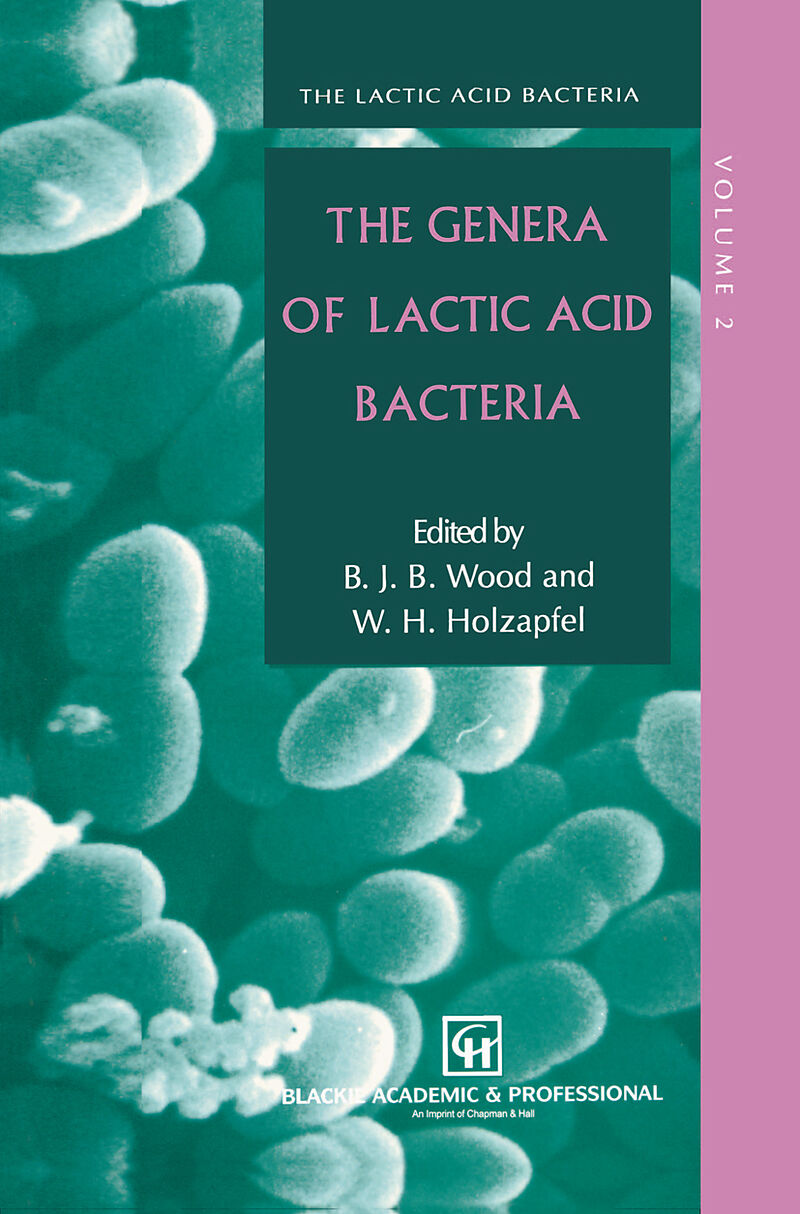The Genera of Lactic Acid Bacteria
Einband:
Fester Einband
EAN:
9780751402155
Untertitel:
The Lactic Acid Bacteria 2
Autor:
B. J. Wood, W. H. N Holzapfel
Herausgeber:
Springer US
Auflage:
1995
Anzahl Seiten:
416
Erscheinungsdatum:
30.11.1999
ISBN:
075140215X
The Lactic Acid Bacteria is planned as a series in a number of volumes, and the interest shown in it appears to justify a cautious optimism that a series comprising at least five volumes will appear in the fullness of time. This being so, I feel that it is desirable to introduce the series by providing a little of the history of the events which culminated in the decision to produce such a series. I also wish to indicate the boundaries of the group 'The Lactic Acid Bacteria' as I have defined them for the present purposes, and to outline my hopes for future topics in the series. Historical background lowe my interest in the lactic acid bacteria (LAB) to the late Dr Cyril Rainbow, who introduced me to their fascinating world when he offered me a place with him to work for a PhD on the carbohydrate metabolism of some lactic rods isolated from English beer breweries by himself and others, notably Dr Dora Kulka. He was particularly interested in their preference for maltose over glucose as a source of carbohydrate for growth, expressed in most cases as a more rapid growth on the disaccharide; but one isolate would grow only on maltose. Eventually we showed that maltose was being utilised by 'direct fermentation' as the older texts called it, specifically by the phosphorolysis which had first been demonstrated for maltose by Doudoroff and his associates in their work on maltose metabolism by a strain of Neisseria meningitidis.
Inhalt
1 Lactic acid bacteria in contemporary perspective.- 1.1 Introduction.- 1.2 Carbohydrate metabolism.- Acknowledgement.- Reference.- 2 Phylogenetic relationships of lactic acid bacteria.- 2.1 Introduction.- 2.2 The genera Lactobacillus, Leuconostoc and Pediococcus.- 2.3 The genus Carnobacterium.- 2.4 The genera Streptococcus, Lactococcus, Enterococcus and Vagococcus.- 2.5 The genera Aerococcus, Alloiococcus, Tetragenococcus and Atopobium.- 2.6 The genus Bifidobacterium.- Acknowledgement.- References.- 3 The genus Lactobacillus.- 3.1 Introduction.- 3.2 Grouping of lactobacilli.- 3.3 Description of the species.- Note added at proof.- Acknowledgement.- References.- 4 The genus Streptococcus.- 4.1 Introduction.- 4.2 Classification.- 4.3 Morphology.- 4.4 Cultural characteristics.- 4.5 Biochemistry/physiology.- 4.6 Cell wall composition.- 4.7 Genetics.- 4.8 Phylogeny.- 4.9 Importance of the genus.- 4.10 Identification.- 4.11 Isolation and enumeration.- 4.12 Maintenance and preservation.- 4.13 Species of the genus Streptococcus.- References.- 5 The genus Pediococcus with notes on the genera Tetratogenococcus and Aerococcus.- 5.1 Introduction.- 5.2 Morphology.- 5.2 Physiology.- 5.4 Genetic features.- 5.5 Immunochemistry.- 5.6 Historical aspects.- 5.7 Phylogenese relationships.- 5.8 Importance of the genus.- 5.9 Isolation and enumeration of pediococci.- 5.10 Maintenance and preservation of pediococci.- 5.11 Identification of pediococci.- 5.12 Description of species which comprise the genus Pediococcus.- 5.13 Concluding remarks.- Acknowledgements.- References.- 6 The genus Lactococcus.- 6.1 History.- 6.2 Morphology.- 6.3 Biochemistry and physiology.- 6.4 Genetics and genetic engineering.- 6.5 Phylogeny.- 6.6 Importance.- 6.7 Habitats.- 6.8 Enrichment and isolation.- 6.9 Identification and differentiation.- 6.10 Maintenance and preservation.- 6.11 Species of the genus Lactococcus.- References.- 7 The genus Leuconostoc.- 7.1 Introduction.- 7.2 Growth characteristics.- 7.3 Taxonomy.- 7.4 Genetics.- 7.5 Practical importance.- 7.6 Conclusion.- 7.7 List of species of the genus Leuconostoc.- References.- 8 The genus Bifidobacterium.- 8.1 General description of the genus.- 8.2 Phylogenetic relationships.- 8.3 The importance of the genus.- 8.4 List of species of the genus Bifidobacterium.- References.- 9 The genus Carnobacterium.- 9.1 History.- 9.2 Morphology.- 9.3 Biochemistry/physiology.- 9.4 Genetics.- 9.5 Phylogeny.- 9.6 Importance.- 9.7 Identification.- 9.8 Isolation and enumeration.- 9.9 Maintenance and preservation.- 9.10 Species of the genus Carnobacterium.- References.- 10 The genus Enterococcus.- 10.1 History.- 10.2 Phylogeny.- 10.3 Growth and isolation of enterococci.- 10.4 Phenotypic characteristics of the genus.- 10.5 Identification of the genus.- 10.6 Identification of enterococcal species.- 10.7 Description of species.- References.- 11 Spore-forming, lactic acid producing bacteria of the genera Bacillus and Sporolactobacillus.- 11.1 Introduction.- 11.2 General properties of the genus Bacillus and other spore-forming organisms.- 11.3 Bacillus species forming lactic acid.- 11.4 Sporolactobacillis inulinus.- 11.5 Phylogenetic relationships.- 11.6 Ecology and habitats of lactic acid producing spore-formers.- 11.7 Applications and products.- 11.8 Descriptions of the spore-forming lactic acid producing bacteria.- References.

Leider konnten wir für diesen Artikel keine Preise ermitteln ...
billigbuch.ch sucht jetzt für Sie die besten Angebote ...
Die aktuellen Verkaufspreise von 6 Onlineshops werden in Realtime abgefragt.
Sie können das gewünschte Produkt anschliessend direkt beim Anbieter Ihrer Wahl bestellen.
Loading...
Die aktuellen Verkaufspreise von 6 Onlineshops werden in Realtime abgefragt.
Sie können das gewünschte Produkt anschliessend direkt beim Anbieter Ihrer Wahl bestellen.
| # | Onlineshop | Preis CHF | Versand CHF | Total CHF | ||
|---|---|---|---|---|---|---|
| 1 | Seller | 0.00 | 0.00 | 0.00 |
